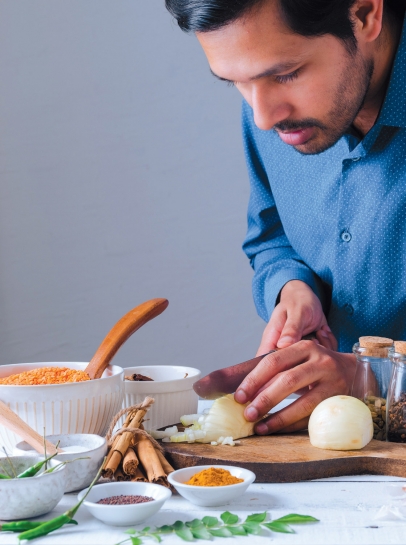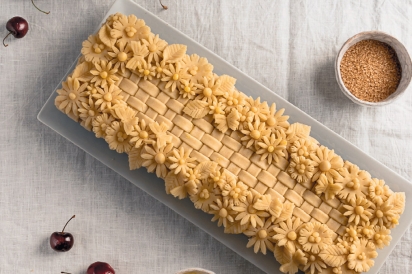An Unexpected Turn of Events
A story of connecting with your home, from half-way across the globe.
Some efforts are born of excess, others of necessity. Amal Abeysekera had moved to the center of a foreign country, was separated from the flavors of his youth, and needed a ride.
Born in Sri Lanka’s commercial capital, Colombo, Amal Abeysekera grew up in a sprawling three million person metropolis located on the country’s west coast and a major sea trade route dating back at least two thousand years, beyond its Portuguese, Dutch, and British colonial history. A religiously and ethnically diverse country, Sri Lanka’s modern culinary history is deeply influenced by its access to many flavorful spices, proximity to India, and its past. Dozens of rice variants, coconuts, and a myriad of spices make for key components to Sri Lankan meals. One such component found in many homes is a collection of spices known as thuna paha. Translated as “three by five” or “three to five”, thuna paha’s three basic ingredients include coriander, cumin, and fennel, with curry leaves and Sri Lankan cinnamon as frequent additions. This mix forms the basis of several culturally important curry dishes as well as Amal’s Instagram account handle, @thunapahadiaries, a modern reflection of how these flavors formed the basis of his tastes and interests in food.
Even though he was surrounded by this rich culinary heritage, Amal describes his childhood self as a picky eater. “I wasn’t a person who grew up baking and cooking,” he reflects on his childhood. “Baking was a black box.” Like many, his earliest memories of food center around his grandmothers. He would accompany his mother and two sisters on an annual trip to visit his maternal grandmother, Lynette Kuruvilla, to bake their Christmas cake, similar to a classic fruitcake, with fruit preserves, nuts, dried fruit, brandy, and Christmas pudding flavor. Though he tried to help, Lynette’s interest in accuracy and adherence to her personal methods was a higher threshold than his early elementary school aged motor skills and attention span could meet. “She preferred that eggs be beaten in a single direction,” Amal recalls dryly. His paternal grandmother, Irene Abeysekera, was a prodigious baker, a person who produced fresh, delicious bakes, often her signature gingerbread, each afternoon with tea. Surrounded by fabulous food and exceedingly competent cooks and bakers, he was freed from the efforts of preparation during childhood and describes the results of his teenage and early twenties cooking and baking attempts as merely “edible.” After graduating university, Amal found himself applying to several schools in the United States. He connected with a professor and fellow Sri Lankan at the University of Oklahoma, Chitru Fernando, and began his graduate studies in Finance in 2015.
Amal was missing something. With no family close enough to make the meals of his youth, he called on his closest relative, an aunt living in Ft. Worth, Texas, to help him address this newfound absence. Amal didn’t have a driver’s license yet and was too nervous to drive anyway, so he took the train south. Like many kind family members of a new arrival, his aunt would provide him with ingredients and snacks from the home country during his monthly Amtrak trips. He would return with an ice box care package full of Sri Lankan flavors which could last him through the month. This routine built a safety net while acclimating to his new location. The reliance on this safety net, however, prevented Amal from stepping outside his comfort zone until 2016 when the aunt moved to the Pacific Northwest and he was left without the connection to his home. It was at this point that two elements collided to create a cook out of him. First, he started cooking traditional Sri Lankan dishes on his own. Whether it was with the help of family recipes for dahl or beetroot curry or YouTube tutorials, Amal began experimenting. Second, he developed an interest in the Great British Baking Show and its master class tutorials with early host Mary Berry. He watched every episode and became increasingly inspired to step further outside of his wheelhouse. Soon, Amal was spending part of each week choosing recipes and gathering materials to execute a new dish or bake, working to perfect spice combinations or prevent the much maligned “soggy bottoms.” A lecturer of finance focusing on corporate social responsibility at OU, Amal knows what drove him from cooking his family recipes towards baking. “I like structure. Everything has to be precise.” It’s not surprising that someone whose most recent work was published in the Journal of Corporate Finance found precision and process as a source of comfort.
The interest in baking’s exactitude, however, doesn’t mean Amal trades away creative spark in favor of precise measurements. His Instagram feed is replete with evidence of his artistic side. Dramatic lighting, props, and flourishes of color find their way into his photography. But, he has a history here, too. Amal’s family includes fine painters and he has been playing violin since childhood, even composing chamber music as a teenager. Now, his baking soundtrack shuffles between classical and mid-twentieth century Sri Lankan pop songs, an atmosphere that “makes you feel like you’re home,” even if home is over nine thousand miles away.
Learning these new skills solved another problem for Amal. While he’d been in the US for over a year now, he still hadn’t obtained a driver’s license. A legacy of British colonialism, Sri Lankans drive on the left side of the road. The anticipated stress of trying to unlearn this pattern meant Amal had relied on Amtrak, ride-sharing apps, and the kindness of friends to travel any substantial distance since arriving in Oklahoma. At the beginning of his cooking and baking efforts, his results were moderate successes he could offer to friends, other PhD students, and roommates who graciously ferried him to locations beyond a walk or bike ride away.
As Amal’s baking skills have grown, so has his popularity on Instagram. With roughly eleven thousand followers, he now talks with other bakers whose work he admires and engages with the dozens of people who comment on the high quality of his work. Of course, this was never part of his purpose. He dryly describes his new reality and online popularity as an “unexpected turn of events.” So much so that at the end of 2020, he decided it was time to reflect on his growing reputation. “I needed to ask myself, what am I doing here and what is my objective? I needed to be mindful of not getting carried away by this.” Finance continues to be his primary focus, but his interest in baking and communicating its joy and technique to others is steadily rising. “I wasn’t a person who grew up baking and cooking. I want to show others it’s something that a person can do at home.” It’s this new purpose that Amal believes will drive him forward in 2021 and beyond.
For Amal, cooking has been a way to maintain a connection with his cultural heritage and baking a means to express his creativity and motivate others to do the same. There are additional benefits, too. He no longer hauls an icebox across the Red River via train. Finding rides isn’t as much of a problem. Now, Amal admits, when he posts a new creation on Instagram, he’ll receive a handful of attentive direct messages from former drivers asking if he needs a ride. Maybe this was foretold. An inevitable consequence of fate. Before her passing and unbeknownst to him, Irene once told the family Amal had inherited her baking genes. Her recipe card for the gingerbread of his youth now belongs to him.
Dhal is a staple in many South Asian cuisines. Sri Lankan dhal is unique as it is cooked with coconut milk, a favorite ingredient in this island nation’s cuisine. This recipe calls for both “thick” and “thin” coconut milk. Traditionally, coconut milk is produced by squeezing freshly grated coconut. Thick coconut milk comes from the first extraction and thin coconut milk comes from the second extraction. However, this recipe uses coconut milk powder, which is the best substitute for fresh coconut milk.
This delicious Sri Lankan dhal can be served with white rice, naan, or even just some bread and butter. It pairs well with almost any other South Asian dish and is perfect for any season!
A note on several of the ingredients: coconut milk powder can be purchased online, or you may substitute canned coconut milk for thin coconut milk and canned coconut cream for thick coconut milk. Thai green chilies, curry leaves, and dried red Thai chilies are available at most Indian or other Asian grocery stores. Ceylon cinnamon sticks can be purchased online.








